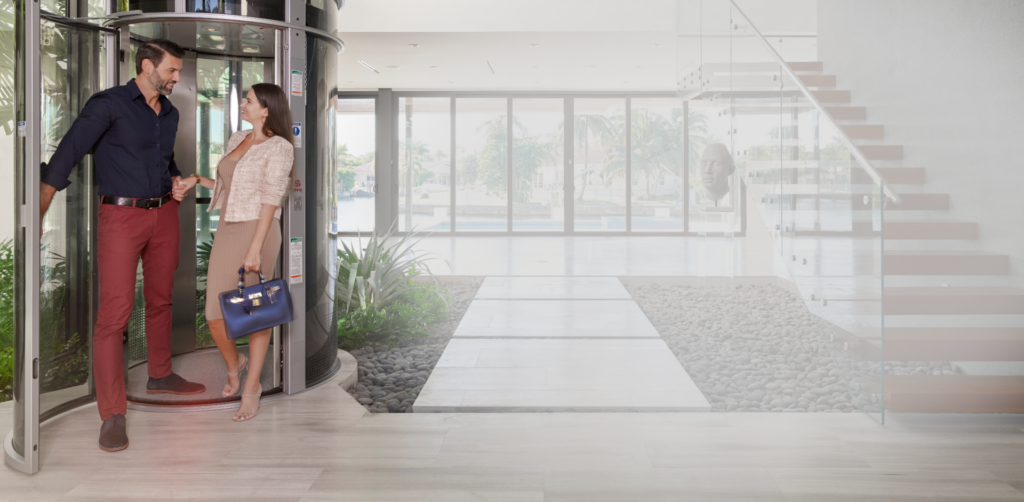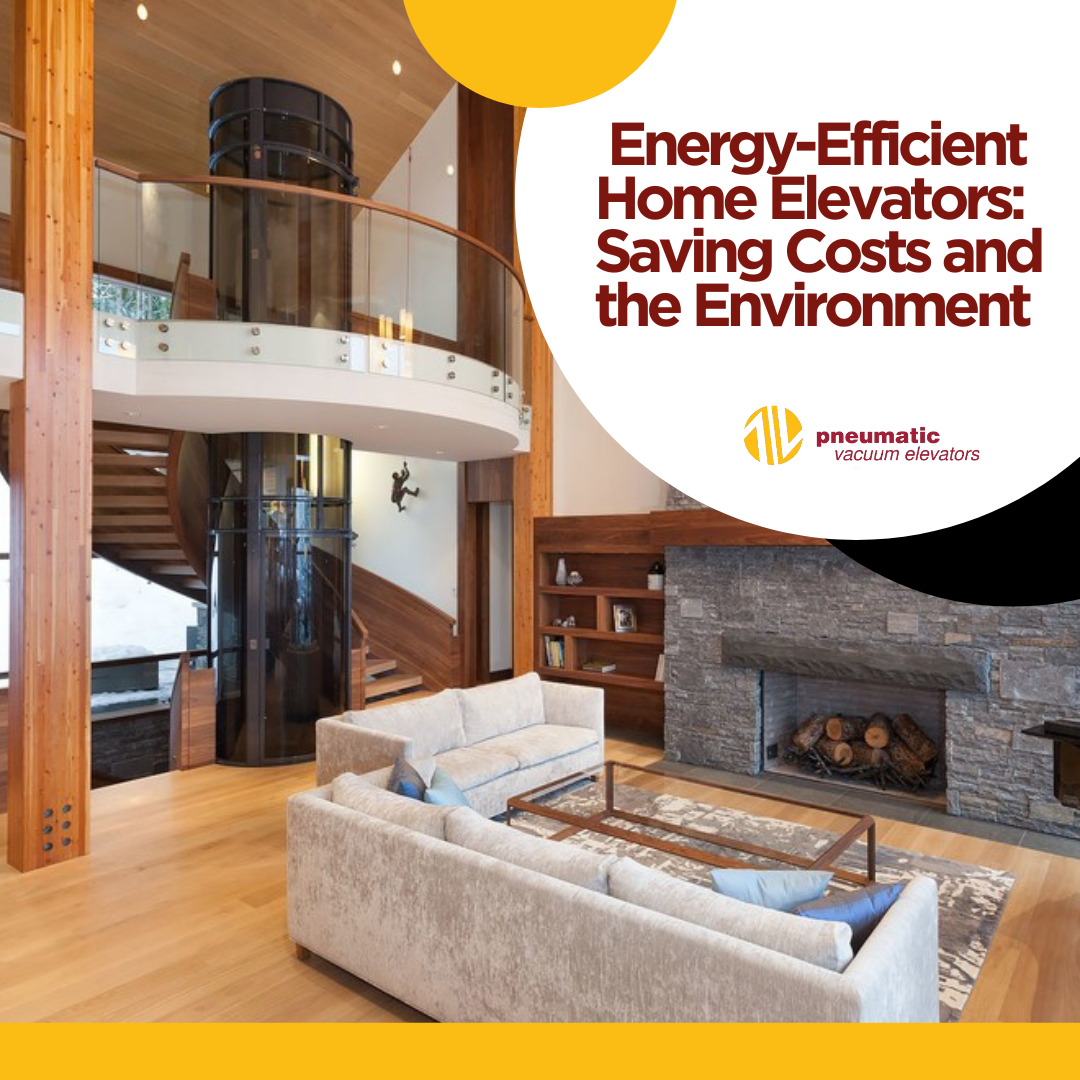Traditional elevators, while undoubtedly a marvel of engineering, can be cumbersome and space-consuming additions to a residence. This is particularly true in multi-story homes with limited floor space or existing construction challenges. In recent years, a novel solution has emerged – the residential tube elevator.
Pneumatic Power: The Core of Tube Elevators

Unlike traditional cable-and-pulley systems, residential tube elevators utilize pneumatic technology for vertical movement. These elevators, also known as vacuum elevators, operate within a transparent, cylindrical tube typically constructed from polycarbonate or acrylic. A powerful vacuum pump located at the top of the tube creates a pressure differential, propelling a pressurized capsule containing the passengers upwards. Descending utilizes gravity and strategically placed pressure relief valves.
Advantages of Residential Tube Elevators
The unique design of residential tube elevators offers several advantages over traditional options:
- Space Efficiency: A key benefit is their compact footprint. Eliminating the need for a dedicated elevator shaft, machine room, or pit dramatically reduces the required space. This makes them ideal for retrofitting existing homes or incorporating into new builds with limited square footage.
- Simplified Installation: The modular design of tube elevators allows for a relatively quicker and less disruptive installation process compared to traditional elevators. Minimal construction modifications are required, and the self-supporting structure eliminates the need for extensive load-bearing reinforcements.
- Aesthetics and Ambiance: The transparent tube transforms the elevator from a utilitarian necessity into a design element. Natural light floods the capsule, fostering a sense of openness and minimizing feelings of claustrophobia. The panoramic views can even become a conversation starter, showcasing the home’s interior architecture.
- Energy Efficiency: The pneumatic operation of tube elevators translates to lower energy consumption compared to traditional elevators that rely on electric motors and counterweights. This not only reduces environmental impact but also translates to lower operating costs.
- Accessibility Considerations: Certain models of tube elevators can be designed to accommodate wheelchairs, making them a valuable accessibility tool for individuals with mobility limitations.
Considerations for Residential Tube Elevators
While tube elevators offer significant advantages, it’s crucial to consider some key aspects before making a decision:
- Capacity and Weight Limits: These elevators are typically designed for single passengers or a maximum of two, with corresponding weight limitations. They might not be suitable for transporting large objects or multiple people.
- Travel Height Limitations: The technology has limitations in terms of vertical travel distance. Most residential tube elevators are suitable for two or three stories, with a maximum travel height of around 50 feet (15 meters).
- Safety Features: Tube elevators incorporate various safety features, including emergency stop buttons, pressure monitoring systems, and automatic door locks. However, it’s essential to ensure the chosen model complies with all relevant safety standards and building codes.
- Noise Levels: The operation of the vacuum pump can generate some noise, though advancements in technology have reduced this significantly. Placement and soundproofing considerations might be necessary.
- Cost: While generally less expensive than traditional elevators, tube elevators still represent a significant investment. The final cost depends on factors like model, customization options, and installation complexity.
Future Advancements in Tube Elevator Technology
The field of residential tube elevator technology is continuously evolving. Here are some potential areas of future development:
- Increased Capacity and Travel Height: Advancements in materials and engineering could pave the way for models capable of handling higher weight capacities and longer travel distances.
- Enhanced Noise Reduction: Further improvements in soundproofing techniques could minimize operational noise, making tube elevators even more suitable for residential environments.
- Smart Integration: Integration with smart home systems could allow for features like voice-activated controls or automatic operation based on user presence.
- Personalization Options: A wider range of customization options for the capsule interior and tube material could allow for a more personalized aesthetic integration with the home’s design.
A Breakdown of Tube Elevator Installation
While the installation process for residential tube elevators boasts advantages like speed and minimal disruption compared to traditional elevators, it still requires careful planning and skilled execution. Here’s a breakdown of the key steps involved, along with potential challenges to anticipate:
1. Pre-Installation Planning and Permitting:
- Site Evaluation: A thorough evaluation of the home’s structure, foundation, and available space is crucial. This includes assessing load-bearing capacity and identifying the optimal placement for the tube and entrance points on each floor.
- Building Code Compliance: Building codes often have specific requirements for elevators, including safety features, weight capacity, and emergency protocols. Consulting with local building authorities and obtaining the necessary permits is essential.
- Detailed Design and Engineering: Detailed architectural and engineering plans are created, specifying the elevator model, tube material and thickness, anchoring points, and any necessary structural modifications.
Challenges: Hidden structural elements within walls or floors might necessitate additional exploratory work. Obtaining permits can involve delays depending on local regulations.
2. Preparation and Foundation Work:
- Interior Modifications: Minor modifications might be required to create openings in floors for the elevator entrance points. Wall reinforcements might be necessary depending on the chosen anchoring method.
- Foundation Pad Installation: A concrete pad with precise leveling ensures a stable foundation for the elevator structure. The pad’s size and reinforcement requirements will depend on the specific model and weight capacity.
Challenges: Existing utilities within walls or floors might need rerouting. Structural modifications should be planned meticulously to minimize disruption and maintain the integrity of the building.
3. Tube and Elevator Component Assembly:
- Tube Installation: The pre-fabricated tube sections are carefully hoisted and secured at designated anchor points. Alignment and leveling are critical to ensure smooth operation.
- Elevator Capsule Assembly: The elevator capsule, including interior finishes and safety features, is assembled according to the manufacturer’s specifications.
Challenges: Working with large and potentially heavy tube sections can require specialized equipment and skilled labor. Ensuring precise alignment throughout the tube assembly is vital.
4. System Integration and Testing:
- Vacuum System Installation: The vacuum pump and associated piping are installed at the designated location, typically at the top of the tube.
- Control System Integration: The control system, including buttons, safety sensors, and emergency features, has wiring and programming.
- Comprehensive Testing: Rigorous testing should be there to ensure proper operation of the elevator, including travel speed, door functionality, safety features, and emergency protocols.
Challenges: Leakage detection and rectification within the pneumatic system is crucial for optimal performance. Safety testing should be there to ensure passenger safety.
5. Final Touches and Training:
- Interior Finishing and Customization: Final touches are applied to the elevator capsule’s interior based on chosen finishes and any desired customization options.
- Homeowner Training: The homeowner receives thorough training on the operation of the elevator, including safety protocols and emergency procedures.
Challenges: Unexpected modifications or adjustments are necessary during the finalization stage. Ensuring clear and comprehensive training for homeowners is vital for safe and proper elevator usage.
By understanding the installation process and potential challenges, homeowners can make informed decisions and work effectively with contractors to achieve a smooth and successful tube elevator installation.
Frequently Asked Questions about Residential Tube Elevator Installation
1. How long does the installation process typically take?
The installation timeline for a residential tube elevator can vary depending on several factors, including the complexity of the project, the chosen model, and any necessary permitting processes. Generally, the process can range from a few weeks to a couple of months. Pre-installation planning and permitting can take the longest, followed by the actual installation steps. Working with an experienced contractor who can accurately estimate the timeline based on your specific project is crucial.
2. What level of disruption can I expect during the installation?
One of the significant advantages of tube elevators is the relatively minimal disruption compared to traditional elevators. Most of the work involves modifications to the specific floors where entry points will be located and the foundation pad installation. Dust and noise reduction can take place with proper dust control measures and scheduling noisy tasks strategically. Reputable contractors will work diligently to keep disruption to a minimum and maintain a clean work environment.
3. Do I need to make any structural changes to my home to accommodate a tube elevator?
The extent of structural modifications required depends on the chosen model and your home’s existing structure. In most cases, minor modifications like wall reinforcements and floor openings for entry points might be necessary. A thorough evaluation by a structural engineer during the planning stage will determine the specific modifications needed to ensure the safe and stable integration of the elevator.
4. Who should I hire for the installation process?
Hiring a qualified and experienced contractor specializing in residential tube elevator installations is paramount. Look for contractors with a proven track record, positive customer reviews, and proper certifications for working with this specific type of elevator system. Ensure they are familiar with local building codes and have the necessary expertise to handle all aspects of the installation process, from planning and permitting to final testing and training.
5. What safety measures are in place during and after installation?
Safety is a top priority throughout the installation process. Reputable contractors will prioritize worker safety with proper personal protective equipment and adhere to safety protocols while working with heavy components and electrical systems. Once installed, tube elevators incorporate various safety features like emergency stop buttons, pressure monitoring systems, and automatic door locks. Homeowners receive comprehensive training on the operation and emergency procedures to ensure safe and proper elevator usage.








